
14 minute read
Expanding Edinburgh’s trams
Extending EDINBURGH’S TRAMS
DAVID SHIRRES
2001 tram network proposal.
In 2013, few in Edinburgh would have wanted an extension to the tram network. At the time, the trams were a toxic subject in the city. The tram project was causing massive disruption in the city, was three years late, almost £300 million over its £490 million budget and was not delivering the full project.
Businesses and residents along Leith Walk had a particular reason to feel aggrieved. They suffered during the tram’s utility works but were not to benefit from the tram as, in 2011, the cost overrun resulted in a decision not to build the section from Newhaven and Leith to Edinburgh.
A tram network was part of the City of Edinburgh Council’s 2001 new transport initiative. This proposed a 35-kilometre tram network for which construction was authorised by Acts of the Scottish Parliament in 2006. However, due to funding issues, the Council decided only to build the 18.5 kilometres between Newhaven and the Airport for which tram and infrastructure contracts were let in 2008. CAF won the contract to supply 27 lowfloor trams, which, with the curtailment of the Edinburgh to Newhaven section, were twice the number required. The trams were delivered on time from 2010 onwards and had to be stored in a nearby industrial estate until the delayed infrastructure was ready for them.
Despite the tram’s difficult beginnings, once the system opened in 2014, the trams proved to be popular, with

ridership well above original predictions and consistently high customer satisfaction scores.
Newhaven extension approved
By 2015, support for completing the original tram project to Newhaven was such that the Council commissioned the production of an outline business case, which was published in 2017. In 2018, the business case was finalised, there was a public consultation exercise and invitations to tender for the tram extension were issued, pending its approval.
The final business case costed the extension at £207 million and concluded that it had a cost benefit ratio (BCR) of 1.4. This is perhaps not surprising as the extension requires no additional trams and much of the utility clearance work had already been done.
Moreover, the BCR did not include its wider economic benefits. The Newhaven extension will serve one of the most densely populated areas
of the city. It also enables the tram to link three of the city’s four priority investment zones - Leith waterfront, the city centre and Edinburgh airport - and so provides employment opportunities that would not be possible without high-capacity public transport.
Another uncosted benefit is that the tram is part of the Council’s Sustainable Energy Action Plan and will both facilitate modal shift to potentially net-zero carbon transport and encourage active transport, as cycling paths will be created alongside tram lines.
The business case envisaged an eventual peak service of eight trams an hour between Edinburgh and Newhaven overlaid with 8 trams an hour (initially 4) between Haymarket and Newhaven. This service would require 25 of the city’s 27 trams. It forecasts annual journeys of 15.7 million once the extension was complete rising to 21.6 million by 2032. Pre-Covid journeys on the current network were 7.4 million a year.
In March 2019, the Council approved the Newhaven tram extension. This was just two years before its powers to build the extension, granted under the 2006 Edinburgh Tram Act, were due to expire. The CAF-build trams are 43 metres long and have seven articulated modules, four of which have a single bogie with the three suspended between the bogie modules.

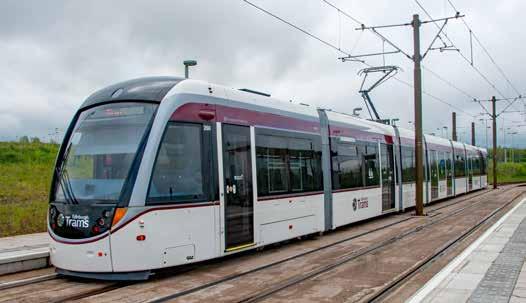
Tram works at Ocean Terminal, a shopping and leisure centre opened in 2001 as part of Leith’s urban renewal and home to the Royal Yacht Britannia.
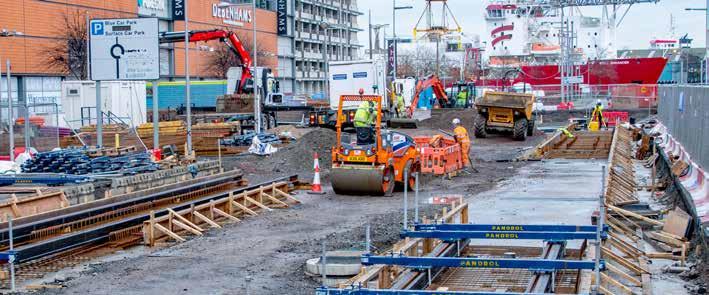

The tram terminus at York Place. The extension
Extending the tram to Newhaven requires 4.6 km of electrified double tram track as well as two new substations. There are crossovers at the Newhaven terminus station and turnbacks at Ocean Terminal and Balfour Street stations. All stations have island platforms except for Foot of the Walk and the Newhaven terminus stations.
The double track extends beyond Newhaven station to provide a stabling facility for two trams with appropriate security measures. The work also includes the removal of the current single-track terminus at York Place, to be replaced by a new Picardy Place station immediately to the east.
The only significant earthworks are a ramp to raise the formation to its terminus at Lindsay Road in Newhaven. No new bridges are required, although the tram formation crosses a railway line under Leith Walk and a bridge over the Water of Leith at the docks. There is also the requirement to replace two roundabouts near Picardy Place by a series of signal-controlled junctions and smaller islands. The complex road junction at the bottom of Leith Walk also requires adjustment of traffic lanes and signal timings.
There are also four supplementary projects that are separately funded and are being progressed in parallel to the tram extension project. These include traffic calming, revised access arrangements and a cycleway between Foot of the Walk and Ocean terminal.
Community and business support
One of the lessons learned from the original tram project was the need for better engagement with the local community and to support those affected, particularly local businesses.
This started with the 2018 consultation exercise and resulted in eight design changes in respect of cycle paths, road layout, crossing points and public realm design. A communication strategy was developed that considered the needs of all stakeholders and how best to communicate with them to ensure their concerns are addressed. This includes a complaints hotline which is manned from 07:00 until one hour after work finishes.
The project publishes a regular stakeholder and communication dashboard which shows that around 500 contacts are made per month that take an average of 82 hours to resolve. The main sources of enquiries are email (46%), Twitter (23%) and phone (23%).
There is also a £2.4 million business support package for independent businesses that depend on customer footfall and are affected by the works. This provides: » A dedicated business support team to provide support and assistance; » Free improvement courses in areas such as e-commerce, marketing and web design; » Business continuity fund to help with short-term cash flow issues during project construction; » Discount vouchers which can be purchased online to spend in local stores; » Free cargo bike hire provided in collaboration with
SUSTRANS to help businesses move goods and service customers; » Five logistics hubs for the delivery and despatch of goods from business where tram works prevent normal loading. These can also be used by residents for the delivery of bulky items. These were designed in accordance with feedback received from 227 businesses.
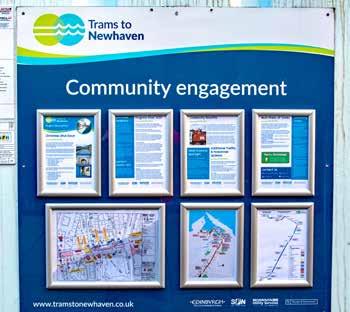
The contracts
In March 2019, the Council awarded two contracts for the tram extension. The first was a design and build Infrastructure and Systems Contract (ISC) for a value of £90 million. This was awarded to a joint venture of Farrans, Sacyr and Neopul (SFNJV). Farrans had constructed the 2.7km section of the Edinburgh tram project between Gogarburn and Edinburgh Airport.
The second was a £25 million Swept Path Contract (SPC) to clear utilities and obstructions below ground and for the tram’s overhead line system. This contract also includes the requirement for archaeological investigations as part of the route clearance. This was awarded to Morrison Utility Services (MUS).
These contracts included a six-month Early Contractor Involvement (ECI) stage, in which the two contractors engaged with stakeholders to plan the work and associated traffic management, undertake detailed design, develop a fully integrated programme and other project documentation including a stakeholder management plan. A decision was then made to proceed with the project, after it was confirmed that costs were still acceptable.
Siemens Mobility was also involved at this ECI stage, under a direct contract with the Council. Once notices to proceed were issued, Siemens was sub-contracted to SFNJV under terms previously negotiated with the Council for the delivery of electrification, SCADA (Supervisory Control and Data Acquisition), telecoms and tram and road traffic signalling. The programme
The project is planned to take 46 months from contract award to start of service. After contract award in March 2019, the ECI stage was completed in November 2019, whereupon the contractors were given a notice to proceed with physical works. However, the work had to be paused from 27 March due to the Covid lockdown and resumed on 15 June, once suitable arrangements were in place.
The original plan was for construction to be completed by October 2022, although this may be impacted by the Covid stoppage. Thereafter a fourmonth period of testing and commissioning is planned before the start of service in Spring 2023.
A key aspect of the programme is the ‘one dig’ approach, which establishes each worksite only once and removes it only when work is complete. This requires close working between the STC and ISC contractors and was one of the lessons learnt from the original tram project. (Above) Foot of the Walk logistics hub on part of the route where work has yet to start. (Inset) Utility work on Leith Walk.

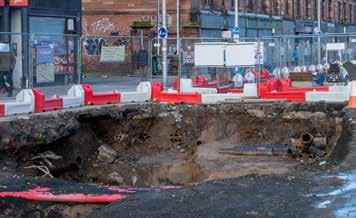
Part of the Leith Walk worksite cleared of utilities.
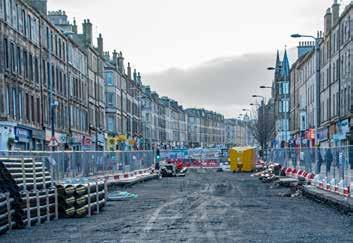
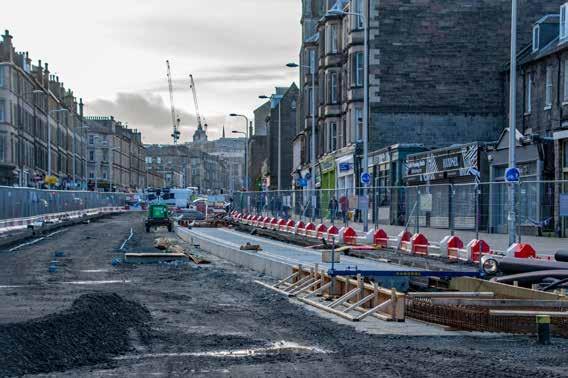
Track laid on Leith Walk.
Pandrol jigs position encapsulated rails.
Whilst many utilities were removed during the original tram project, there remain significant challenges, such as a 500mm gas main in Leith Walk.
The programme divides the work into 17 worksites, of which the longest is 1.4 kilometres between London Road and Manderston Street on Leith Walk. This was one of the earliest worksites to be established, due to the number of utilities and the many businesses along it.
However, traffic management arrangements had to be set up first. This made road traffic on Leith Walk one-way towards the city centre on a single lane with the worksite in the centre and a cycleway on the other side.
As of January, the SFC contract had cleared sixty per cent of the Leith Walk worksite for the ISC to start tracklaying along most of it.
Amongst the last work to be done will be the complex road junctions at the top and bottom of Leith Walk. To maintain a service to the end of the current tram line, the final worksite will be the demolition of York Place tram stop and tying in the existing track to the new extension. It is envisaged that work will start here in the winter of 2021/22. QTrack
In March 2020, 11,000 18metre-long tram rails arrived at the port of Leith, where the project has a warehouse to encapsulate the rails for track laying. For curves below 100 metre radius, rails were sent to British Steel in Scunthorpe to be pre-bent to remove internal stresses.
The tram extension uses the Pandrol QTrack embedded ballastless track system. This encapsulates the rail in specially shaped, elastic, prefabricated, resin-bonded rubber profiles to give the required stiffness characteristics and electrical insulation. The system does not have sleepers and so offers an even load distribution with lower vibration. The encapsulated rails are installed in a reinforced concrete slab which supports the rail. Whilst this is being done the rails are positioned and supported by adjustable jigs which, on straight track, are approximately 1.5 metres apart. The track can be installed at a rate of 144 metres per day.
Archaeology and heritage
Leith has a long history as Edinburgh’s port, and so archaeological investigations were an essential part of the route clearance work. This was done in close consultation with the city’s archaeologist and undertaken by Guard Archaeology, which was sub-contracted to the SPC contractor, Morrison Utility Services.
Much of this work took place adjacent to the 1790s A-listed South Leith Parish Church. Here, the graveyard wall was very close to the tram track and so had to be dismantled and rebuilt with improved foundations. Whilst this was being done, an archaeological dig outside the graveyard in front of the wall found 359 bodies, many of which are thought to date from between 1300 and 1650. These were removed for forensic analysis to reveal information about the health, diseases and diet of medieval Leith’s population.
Other historic finds, some of which date back to the 16th and 17th centuries, include whale bones, which may shed light on the town’s historic whaling industry, a cannonball, historic drainage, a large stone wall and a possible slipway. These date from the early development of the town and indicate that reclamation of
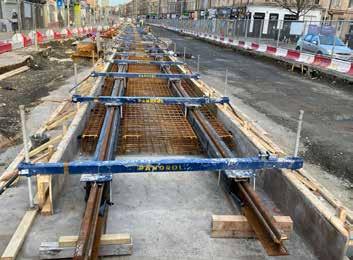

parts of Leith from the sea could have occurred earlier than first thought.
Of more recent historic interest was a time capsule, buried under a statue of Robert Burns in Constitution Street that was erected in 1898. This statue had to be moved in January 2020 and will be replaced, two metres to the east, when construction works are complete. The capsule contained various historic artifacts including information about the Leith Burns Club, which had erected the statue.
Lessons learnt
When Newhaven and Leith get their tram service in 2023, this will complete phase 1a of the original tram network. Yet, in 2008, a contract was let to complete it in 2011. This 12-year delay - the result of the sorry saga of the original tram project -is now the subject of a public inquiry which was announced in June 2014. It held its preliminary hearing in October 2015, public hearings in September 2017, heard closing submissions in May 2018 and has, so far, cost £11.3 million.
The Edinburgh tram inquiry has therefore now taken longer than the delayed tram project itself, and has still yet to report. Its website states that “At the appropriate time, Lord Hardie will make his report and findings available here.” The website also contains 189 hearing transcripts, 228 witness statements and 6,428 supporting documents.
Amongst the key issues being considered by the inquiry are that on award of the infrastructure contract, the preferred bidder found that only 60 per cent of detailed design had been done, many third-party approvals were outstanding and that the utility works were very far from complete. These were due to have been completed before the contract was let.
At the time, the political imperative would not allow any delay to the project. Hence, there was no question of delaying the infrastructure contract award until these issues were resolved. As the contractor was not prepared to accept the fixed price contract required by the client, an additional contract schedule was negotiated which, as far as the contractor was concerned, required the client to accept the risk of these uncertainties.
Yet, the client understood that the contract had a “high degree of fixity in the price.” At the inquiry, comments from senior Edinburgh Council officials included “the belief that there was a fixed price contract turned out to be erroneous” and “We finished up with a contract that very senior legal people and adjudicators in the dispute resolution were saying later that they didn’t know what it meant.”
One expert report noted that the Council was “being asked to agree to a contract where the design specification was incomplete with the contractor having an integral role in project design (the design contract was transferred to the contractor on contract award). This position effectively set the foundational conditions for conflict, delay and a significant recalibration of outcomes.”
The contractor also noted that the utility work, which should have been completed before the infrastructure contract award in 2008, was the biggest delaying factor with many diversions ongoing up to 2012.
It is unfortunate that its findings could not have been available to those setting up the Newhaven tram extension project. Yet the above issues, and other difficulties with the original project, are well known to those who have studied it. No doubt, this includes those managing the tram extension project. Certainly, it would seem that lessons from the original project have been taken on board. For example, hardly a year into the contract, 60 per cent of the utilities on Leith Walk have been cleared.
None of the above detracts from the benefits of finally having trams in Edinburgh. They have proved popular, ridership was steadily increasing until the Covid lockdown and they have high passenger-satisfaction ratings.
Nevertheless, given the history of the Edinburgh tram project, there are some on the Newhaven tram extension route who feel its cost is not justified. Leith and Newhaven have waited a long time for their trams. When they enter service in 2023, hopefully, the benefits to the local community will be clear and it will have been worth the long wait. Completed track on Ocean Way, Leith.
Trams running on Leith Walk from 2023.











